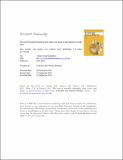Files in this item
The role of sexually dimorphic skin colour and shape in attractiveness of male faces
Item metadata
| dc.contributor.author | Carrito, Mariana | |
| dc.contributor.author | Santos, Isabel Maria Barbas dos | |
| dc.contributor.author | Lefevre, Carmen Emilia | |
| dc.contributor.author | Whitehead, Ross David | |
| dc.contributor.author | Silva, Carlos Fernandes da | |
| dc.contributor.author | Perrett, David Ian | |
| dc.date.accessioned | 2016-09-25T23:34:46Z | |
| dc.date.available | 2016-09-25T23:34:46Z | |
| dc.date.issued | 2016-03 | |
| dc.identifier | 219965135 | |
| dc.identifier | 1b2c18c1-a7b2-42ea-a1e0-b9befd83b8f1 | |
| dc.identifier | 84960230498 | |
| dc.identifier | 000370888300005 | |
| dc.identifier.citation | Carrito , M , Santos , I M B D , Lefevre , C E , Whitehead , R D , Silva , C F D & Perrett , D I 2016 , ' The role of sexually dimorphic skin colour and shape in attractiveness of male faces ' , Evolution and Human Behavior , vol. 37 , no. 2 , pp. 125–133 . https://doi.org/10.1016/j.evolhumbehav.2015.09.006 | en |
| dc.identifier.issn | 1090-5138 | |
| dc.identifier.other | RIS: urn:69486001EF41A1069FEF10763D12E165 | |
| dc.identifier.other | ORCID: /0000-0002-6025-0939/work/64360981 | |
| dc.identifier.uri | https://hdl.handle.net/10023/9550 | |
| dc.description | This research was supported by funding from Foundation for Science and Technology (FCT) and the POPH/FSE Program (grant reference SFRH/BD/77592/2011). | en |
| dc.description.abstract | Evidence for attraction to sexually dimorphic features in male faces is inconsistent in the literature. Mixed results regarding facial masculinity and male attractiveness may arise partly from different influences of face shape and face colouration depending on whether colour was controlled. Recent research suggests that masculinity in face colour, namely darker skin, and femininity in shape are attractive in male faces. Here we examine the influence of sexual dimorphism in skin colour and face shape on attractiveness in 3 experiments. We allowed female participants to manipulate male and female face images along axes of sexual dimorphism in skin colour and/or shape in order to optimise attractiveness. Participants searching for the most attractive appearance chose to masculinise the colour of male faces more than the colour of female faces (although not reaching significance in Experiment 3; p = .16). We found a clear preference for feminine shape in male faces supporting predictions of recent research. These results help to clarify the influence of facial masculinity in women’s attractiveness preferences. | |
| dc.format.extent | 715797 | |
| dc.language.iso | eng | |
| dc.relation.ispartof | Evolution and Human Behavior | en |
| dc.subject | Face perception | en |
| dc.subject | Attractiveness | en |
| dc.subject | Sexual dimorphism | en |
| dc.subject | Face shape | en |
| dc.subject | Skin colour | en |
| dc.subject | Masculinity | en |
| dc.subject | BF Psychology | en |
| dc.subject | NDAS | en |
| dc.subject | BDC | en |
| dc.subject.lcc | BF | en |
| dc.title | The role of sexually dimorphic skin colour and shape in attractiveness of male faces | en |
| dc.type | Journal article | en |
| dc.contributor.institution | University of St Andrews. School of Psychology and Neuroscience | en |
| dc.contributor.institution | University of St Andrews. School of Medicine | en |
| dc.contributor.institution | University of St Andrews. Child and Adolescent Health Research Unit | en |
| dc.contributor.institution | University of St Andrews. Institute of Behavioural and Neural Sciences | en |
| dc.contributor.institution | University of St Andrews. Centre for Social Learning & Cognitive Evolution | en |
| dc.identifier.doi | https://doi.org/10.1016/j.evolhumbehav.2015.09.006 | |
| dc.description.status | Peer reviewed | en |
| dc.date.embargoedUntil | 2016-09-25 |
This item appears in the following Collection(s)
Items in the St Andrews Research Repository are protected by copyright, with all rights reserved, unless otherwise indicated.

